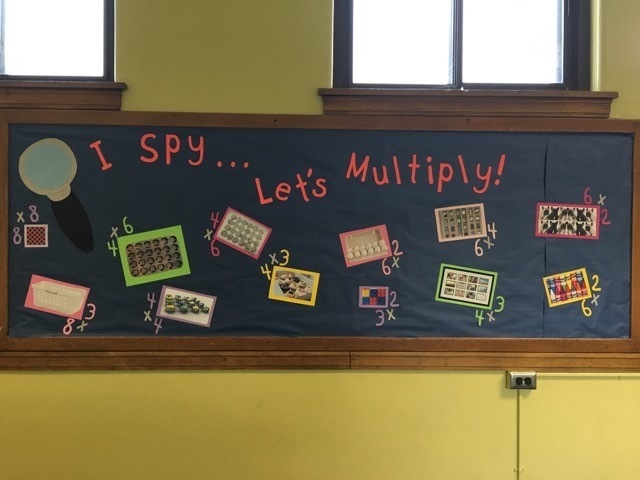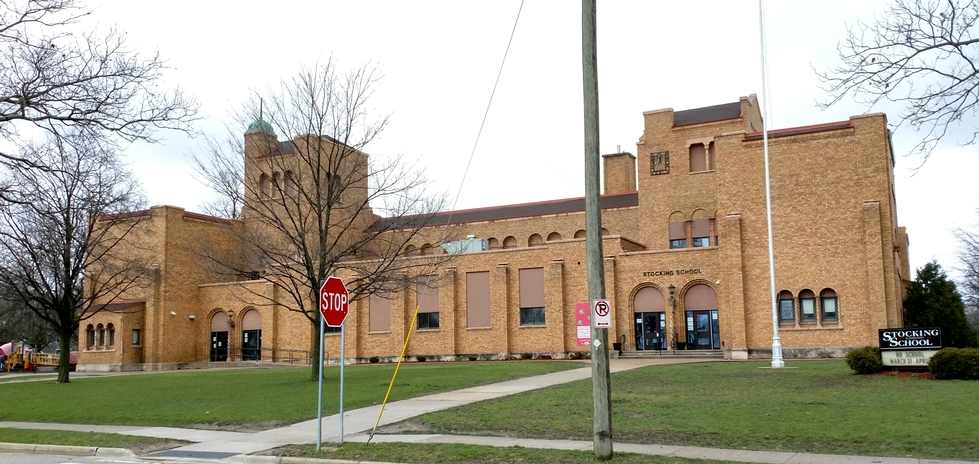The math department takes learning into the community

Since the beginning of this academic year, GVSU students studying elementary teacher education have had the option to choose an amazing opportunity to be involved in community-based learning while taking their required Mathematics for Elementary Teachers II (MTH 222) course. Both semesters, Prof. Esther Billings taught a section of the course that meets most days at an urban school, Stocking Elementary in Grand Rapids. Here, students have the opportunity to regularly apply their mathematics learning in a school setting through a varying and exciting agenda for each day.
Prof. Billings plans her students’ tasks and schedule in collaboration with the principal and teachers, based on the teachers’ evolving needs and course objectives. On some days, students can be in a classroom observing a number talk session, a daily mathematics routine during which children practice solving and sharing their computational strategies, and then later debriefing in the GVSU classroom at the school, analyzing the children’s mathematical thinking and teacher’s instructional decisions. On another day the students might be busy creating math themed bulletin boards for the school corridors. Some days the principal of the school visits to give students insider information on what she looks for when she evaluates a teacher during a classroom visit or when she reviews applications for an open teacher position.
A key component of this course also involves students regularly engaging small groups of children to think mathematically. Working with the teachers and Prof. Billings, students create mini lessons and activities to supplement children’s learning in their classes. Throughout the semester, students pair up and work with a small group of children to teach their lessons. Partnering with another student allows one student to take on the observer role to both record and analyze the children’s thinking and provide support as needed, while the other student can focus on facilitating the lesson. As the students get more experience, they learn to juggle teaching and observing at the same time just as experienced teachers do all the time. Prof. Billings says that her students have found this community-based learning experience extremely positive and beneficial; the students report they have been grateful to having ongoing opportunities to apply their learning with children and have a more realistic sense of what teaching mathematics involves.

Stocking Elementary School
Prof. Billings conceived of teaching this course in this way during her sabbatical in Winter 2013. While working with teachers at the Grand Rapids Child Discovery Center for her sabbatical project, she was reminded of the importance that regularly reflecting on teaching experiences has on improving teaching practices. She felt that our students could benefit from an immersive experience in a K-12 classroom that provided ongoing reflection opportunities based on shared teaching and learning experiences. The next semester when she taught the Mathematics for Elementary Teachers II course, she brought her students to the Child Discovery Center regularly. Prof. Billings co-planned and coordinated with the teachers which activities would be used and which parts of the lesson the teacher would facilitate, and which parts the GVSU students would lead.
After seeing how powerful the experience was for her students to have shared experiences of observing real-time mathematics teaching, jointly working with teachers to facilitate teaching activities, and reflecting together, she wanted to make this type of experience the main focus of the course. After careful planning and in collaboration with the administrators and teachers at Stocking Elementary, GVSU College of Education faculty, and the Office for Community Engagement at GVSU, this community-based version of the course became reality in Fall 2016.
As part of a broader university effort to provide high-impact learning experiences for its students, the Mathematics Department received an Engaged Department Initiative grant funded by the Office for Community Engagement to consider ways to incorporate more community-based learning opportunities into the curriculum. A focus on community-based learning involves connecting and applying what is learned in the classroom to the surrounding community/profession.
The creation of this section of MTH 222 is a first step in our efforts to continue to strengthen our curriculum, both for students intending to become teachers and for those who are not, with the eventual goal of making our courses even more relevant for students’ future careers and providing more real-world applications and opportunities to develop essential life and job skills.

